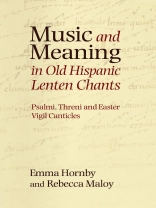The tradition of Old Hispanic liturgical chant is here examined through a new methodology, enabling striking new insights into its use.
Medieval Iberian liturgical practice was independent of the Roman liturgy. As such, its sources preserve an unfamiliar and fascinating devotional journey through the liturgical year. However, although Old Hispanic liturgical chanthas long been considered one of the most important medieval chant traditions, what musical notation to survive shows only where the melodies rise and fall, not precise intervals or pitches. This lack of pitch-readable notation has prevented scholars from fully engaging with the surviving sources – a gap which this book aims to fill, via a new methodology for analysing the melodies and the relationship between melody and text.
Focussing on three genres of chant sung during the Old Hispanic Lent (the threni, psalmi, and Easter Vigil canticles), the book takes a holistic view of the texts and melodies, setting them in the context of their liturgical and intellectual surroundings, and, for the Easter Vigil, exploring the relationship between different Old Hispanic traditions and other western liturgies. It concludes that the theologically purposeful text selections combine with carefully shaped melodies to guide the devotional practice of their hearers.
Emma Hornby is a Reader in Music , University of Bristol; Rebecca Maloy is Associate Professor of Music, University of Colorado at Boulder.
Daftar Isi
Introduction
Thematic Congruity in the Old Hispanic Lenten liturgies
The threni
The Melodic language of the Old Hispanic Lenten Psalmi
Words and Music in the Psalmi
The Easter Vigil Canticles
Afterword: The relationship between the Old Hispanic traditions A and B
Appendix 1: A guide to reading Old Hispanic notation
Appendix 2: The threni texts
Appendix 3: The threni
Appendix 4: The Lenten psalmi in León 8
Appendix 5: The Lenten psalmi in T5, compared with León 8
Appendix 6: Easter Vigil Canticles in León 8 and T5
Appendix 7: Comparison of some Old Hispanic benedictiones in León 8, T5, T4, T7 and Aemil 30
Bibliography












